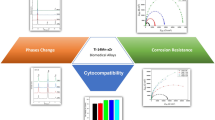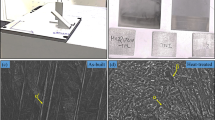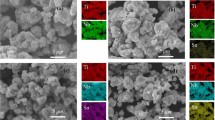Abstract
The effect of anodizing on corrosion resistance of Ti–xHf alloys has been investigated. Ti–xHf alloys were prepared and anodized at 120, 170 and 220 V in 1 M H3PO4 solution, and crystallized at 300 and 500°C. Corrosion experiments were carried out using a potentiostat in 0.15 M NaCl solution at 36.5 ± 1°C. The Ti–xHf alloys exhibited the α′ and anatase phases. The pore size on the anodized surface increases as the applied voltage is increased, whereas the pore size decreases as the Hf content is increased. The anodized Ti–xHf alloys exhibited better corrosion resistance than non-anodized Ti–xHf alloys.










Similar content being viewed by others
References
Rao S, Ushida T, Tateishi T, Okazaki Y, Asao S. Effect of Ti, Al and V ions on the relative growth rate of fibroblasts (L929) and osteoblast (MT3T3-E1) cells. J Biomed Mater Eng. 1996;6:79–86.
Kobayashi E, Gardner LK, Toth RW J. Titanium: the mystery metal of implant dentistry. Dental materials aspects. J Prosthet Dent. 1985;54:410–4.
He G, Hagiwara M. Ti alloy design strategy for biomedical applications. Mater Sci Eng. 2006;C26:14–9.
Steinemann SG. In: Winter GD, Leray JL, de Groot K, editors. Evaluation of biomaterials. New York: John Wiley & Sons Ltd; 1980. p. 1–34.
McLachlan C, Farnell B, Galin H. In: Sarkar B, editor. Biological aspects of metals and metal-related diseases. New York: Raven Press; 1983. p. 209–18.
Perl DP, Brody AR. X-ray spectrometric evidence of aluminum accumulation in neurofibrillary tangle-bearing neurons. Science. 1980;208:297–9.
Sumner DR, Galante JO. Determinants of stress shielding: design versus materials versus interface. Clin Orthop Relat Res. 1992;274:202–12.
Niinomi M. Recent metallic materials for biomedical applications. Metall Mater Trans. 2002;33:477–86.
Niinomi M. Mechanical properties of biomedical titanium alloys. Mater Sci Eng. 1998;A243:231–6.
Long M, Rack HJ. Titanium alloys in total joint replacement-a materials science perspective. Biomater. 1998;19:1621–39.
Saji VS, Choe HC. Electrochemical corrosion behaviour of nanotubular Ti–13Nb–13Zr alloy in Ringer’s solution. Corros Sci. 2009;51:1658–63.
Jeong YH, Kim WG, Park GH, Choe HC, Ko YM. Surface characteristics of HA coated Ti–Hf binary alloys after nanotube formation. Trans Nonferr Metals Soc China. 2009;19:852–6.
Cai Z, Koike M, Sato H, Brezner M, Guo Q, Komatsu M, Okuno O, Okabe T. Electrochemical characterization of cast Ti–Hf binary alloys. Acta Biomater. 2005;1:353–6.
Jeong YH, Lee K, Choe HC, Ko YM, Brantley WA. Nanotube formation and morphology change of Ti alloys containing Hf for dental materials use. Thin Solid Films. 2009;517:5365–9.
Zhou YL, Niinomi M. Passive films and corrosion resistance of Ti–Hf alloys in 5% HCl solution. Surf Coat Technol. 2009;204:180–6.
Kubota S, Johkura K, Asanuma K, Okouchi Y, Ogiwara N, Sasaki K, Kasuga T. Titanium oxide nanotubes for bone regeneration. J Mater Sci Mater Med. 2004;15(9):1031–5.
Kakoli D, Susmita B, Amit B. Surface modifications and cell-materials interactions with anodized Ti. Acta Biomater. 2007;3:573–85.
Limmer SJ, Chou TP, Cao GZ. A study on the growth of TiO2 nanorods using sol electrophoresis. J Mater Sci. 2004;39:895–901.
Kim WG, Choe HC, Ko YM, Brantley WA. Nanotube morphology changes for Ti–Zr alloys as Zr content increases. Thin Solid Films. 2009;517(17):5033–7.
Jang SH, Choe HC, Ko YM, Brantley WA. Electrochemical characteristics of nanotubes formed on Ti–Nb alloys. Thin Solid Films. 2009;517:5038–43.
Saji VS, Choe HC, Brantley WA. Nanotubular oxide layer formation on Ti–13Nb–13Zr alloy as a function of applied potential. J Mater Sci. 2009;44:3975–82.
Saji VS, Choe HC. Phenomena of nanotube nucleation and growth on new ternary titanium alloys. Acta Biomater. 2009;5:2303–10.
Bai J, Zhou B, Li L, Liu Y, Zheng Q, Shao J, Zhu X, Cai W, Liao J, Zou L. J Mater Sci. 2008;43:1880–4.
Zwilling V, Aucouturier M, Darque-Ceretti E. Anodic oxidation of titanium and TA6V alloy in chromic media. An electrochemical approach. Electrochim Acta. 1999;45:921–9.
Jakubowicz J. Formation of porous TiO x biomaterials in H3PO4 electrolytes. Electrochem Commun. 2008;10:735–9.
Song HJ, Kim MK, Jung GC, Vang MS, Park YJ. The effects of spark anodizing treatment of pure titanium metals and titanium alloys on corrosion characteristics. Surf Coat Technol. 2007;201:8738–45.
Zhou YL, Niinomi M, Akahori T. Changes in mechanical properties of Ti alloys in relation to alloying additions of Ta and Hf. Mater Sci Eng. 2008;A483:153–6.
Oh HJ, Lee JH, Jeong YS, Kim YJ, Chi CS. Microstructural characterization of biomedical titanium oxide film fabricated by electrochemical method. Surf Coat Technol. 2005;198:247–52.
Choe HC, Kim HS, Choi DC, Kim KH. Effects of alloying elements on the electrochemical characteristics of iron aluminides. J Mater Sci. 1997;32:1221–7.
Choe HC, Jeong YH, Brantley WA. Phenomena of nanotube nucleation and growth on new ternary titanium alloys. J Nanosci Nanotech. 2010;10:4684–9.
Narayanan R, Seshadri SK. Phosphoric acid anodization of Ti–6Al–4V—structural and corrosion aspects. Corros Sci. 2007;49:542–58.
Mansfeld F. Advances in corrosion science and technology. In Fontana MG, Staehle RW, editors. 6th ed. Plenum Press: New York; 1976.
Acknowledgments
This research was supported by National Research Foundation of Korea (R13-2008-010-00000-0).
Author information
Authors and Affiliations
Corresponding author
Rights and permissions
About this article
Cite this article
Jeong, YH., Choe, HC. & Brantley, W.A. Corrosion characteristics of anodized Ti–(10–40wt%)Hf alloys for metallic biomaterials use. J Mater Sci: Mater Med 22, 41–50 (2011). https://doi.org/10.1007/s10856-010-4188-0
Received:
Accepted:
Published:
Issue Date:
DOI: https://doi.org/10.1007/s10856-010-4188-0




